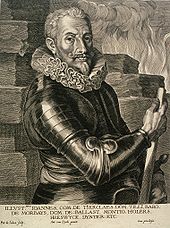Battle of Wiesloch (1632)

The battle near Wiesloch on August 16, 1632, based on an engraving by Matthäus Merian (facing east) In the center of the picture you can see the Protestant town church of Wiesloch, the town wall and the “Leimbach”.
| date | August 16, 1632 |
|---|---|
| place | Wiesloch |
| output | Victory of the Swedish troops |
| Parties to the conflict | |
|---|---|
| Commander | |
|
|
|
In the battle of Wiesloch on August 16, 1632, the Swedes under Gustaf Graf Horn defeated the imperial under Ernesto Montecuccoli .
Apron
Until April 26, 1622, one day before the battle of Mingolsheim , Tilly gathered his troops in Wiesloch and attacked Mingolsheim on April 27, 1622, coming from the north . After he was defeated by Mansfeld in this battle on the Ohrberg mountain and over 2,000 men had fallen on his side, he fled via Östringen , Zeutern , Odenheim through the Katzbach valley to Wimpfen . There he won the Battle of Wimpfen nine days later . Tilly moved on to the battle of Höchst , then retook Heidelberg , Mannheim and Frankenthal (Palatinate) .
The Swedish king Gustav Adolf stepped on the side of the Protestants in 1630, which changed the situation on the theater of war. His triumphant advance led him deep into the German south.
Expulsion of the Imperialists
In the 2nd stage of the Thirty Years War, the Swedes (invasion of Sweden in 1632) with 40,000 men moved into the Electoral Palatinate . The Swedish army pursued the Bavarian troops commanded by Tilly and defeated them in the Battle of Rain am Lech on 14/15. Destructive April 1632. Tilly died of the effects of a wound (tetanus) on April 30, 1632 in Ingolstadt . The Swedes occupied Bavaria .
Wiesloch is conquered and occupied by the Swedes
In May 1632 the Swedes conquered Wiesloch under their general Gustaf Graf Horn . The imperial general Ernesto Montecuccoli (* 1582; † June 17, 1633 in Colmar ) and Colonel Ossa (von) Hanau-Lichtenberg were defeated in this battle.
On July 20, 1632, fighting broke out in Wiesloch between the Swedish occupation soldiers and the Imperial Bavarian cavalry, which suffered a defeat.
The battle in front of Wiesloch's city walls
On August 16, 1632 (not 1633) a battle took place at the gates of Wiesloch . Swedish and Imperial troops faced each other (again?).
"16. August 1632. Due to a misjudgment of the Swedish troop strength, the imperial family is ambushed and retreated south after considerable losses. In Wiesloch, the city mill in front of the southern city wall burns down. Merian records the meeting in detail in an engraving. "
The castle in Rotenberg was destroyed, as were the neighboring towns of Dielheim , Horrenberg and Balzfeld, which belonged to the Speyer monastery and were subordinate to the Kislau office .
After this victory the Swedes occupy Stollhofen and Lichtenau . On August 31, 1632, the Swedes invade Strasbourg . The Swedish troops then occupied Bühl in 1632–34 and 1643.
After Gustav Adolf's death (November 16, 1632 near Lützen), 12,000 Swedish soldiers were leaderless and marched through the country.
Web links
- The Thirty Years War at mortenau.de
literature
- Ludwig Hildebrant, Helmut Mohr: Historical Wiesloch. A guide to the sights of the winemaking town. Verlag KF Schimper, 2000, ISBN 3877421474 .
- Harald Gomille: The history of the community Dielheim with Horrenberg, Balzfeld, Unterhof and Oberhof . (Ortschronik part 1) Thorbecke 1994, p. 356.
- Albert Fuchs: Kronau (Kisslawer Ampts). Small contribution to local history . Publishing house O. Katz, 1927.
- Joh. Phil. Dorinus: Bavarian defeat at Wiesloch and the murders at Hilspach and Necargemündt . Joh. Lancellot, Heidelberg 1622 (State Library Munich, Bavar. 3000 VII.29).
- Josef von Golitschef: 1000 years of market rights. City of Wiesloch, 1965, p. 59 f. (16.8. 1633 )
- Wilhelm Winter, Heinrich Winter: History of the city of Wiesloch. Winter & Winter, 1904.
- Johann Christoph Wagner: The Pfaltz on the Rhine state, country, city and history mirror. Koppmayer, Augsburg 1690, p. 38 here online
Individual evidence
- ^ Home book of the Bad Langenbrücken community, 1969, Huber Druck.
- ↑ Invasion of Sweden in 1632 on the Upper Rhine
- ↑ Chronik der Deutschen , Chronik Verlag, ISBN 3-88379-023-0
- ↑ History mirror p. 38
- ^ The Swedish general Gustaf Graf Horn defeats Colonel Ossa near Wiesloch
- ^ Harald Gomille; Community Dielheim 1994; The history of the community of Dielheim with Horrenberg, Balzfeld, Unterhof and Oberhof, (Ortschronik part 1, p. 356)
- ↑ only very little usable material can be found, some of it contradicting itself. E.g. Albert Fuchs; Kronau, Small Contribution to Local History , 1927. Describes the date of the battle with: " ... August 1632 the imperial family suffered a defeat at Wiesloch, 1633, from June onwards, the Philippsburg fortress was besieged ... " You can also find the Wiesloch website >> August 1632 ( Memento of the original from September 27, 2007 in the Internet Archive ) Info: The archive link was automatically inserted and not yet checked. Please check the original and archive link according to the instructions and then remove this notice.
- ↑ History of Malsch: "1633 ... before the gates of Wiesloch" ( Memento of the original from September 28, 2007 in the Internet Archive ) Info: The archive link was inserted automatically and has not yet been checked. Please check the original and archive link according to the instructions and then remove this notice.
- ↑ see also the copper engraving by Matthäus Merian from: The history of the community Dielheim .. p. 357 the date is noted as August 16, 1633 .
Coordinates: 49 ° 17 ′ 36.5 ″ N , 8 ° 40 ′ 19.5 ″ E

